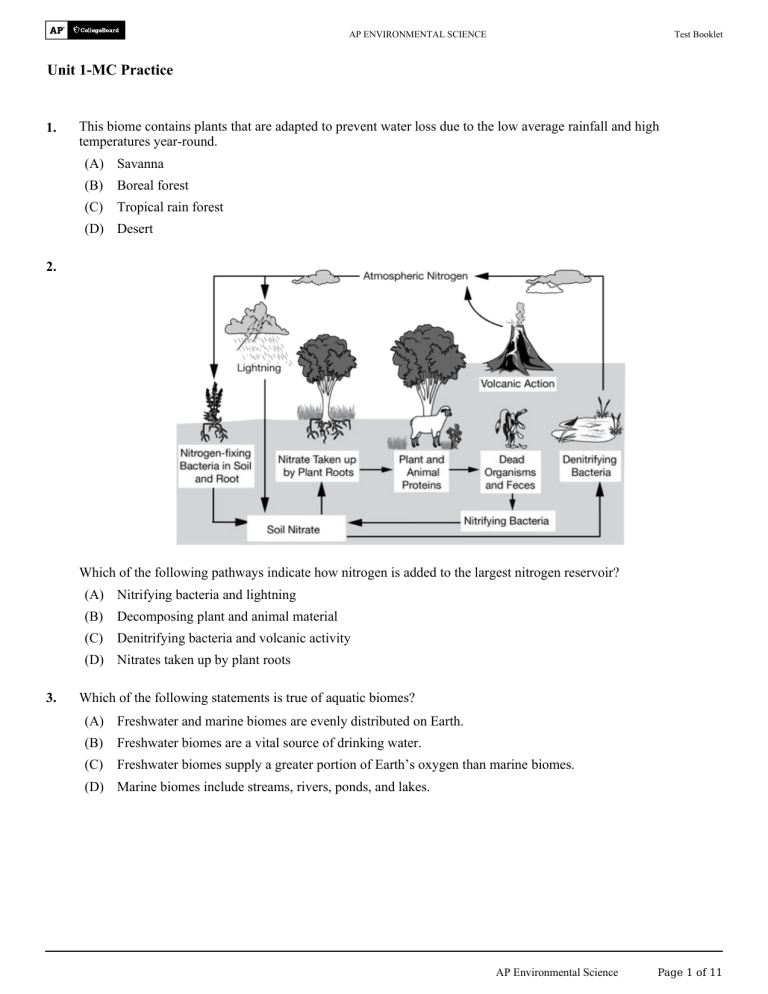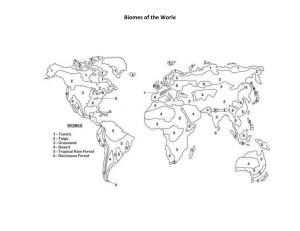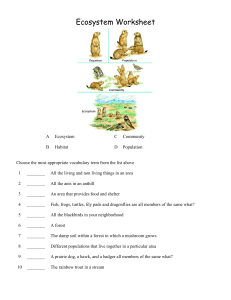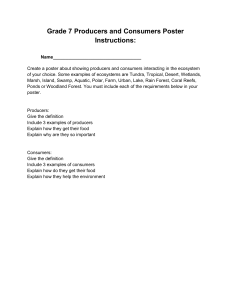
AP ENVIRONMENTAL SCIENCE Test Booklet Unit 1-MC Practice 1. This biome contains plants that are adapted to prevent water loss due to the low average rainfall and high temperatures year-round. (A) Savanna (B) Boreal forest (C) Tropical rain forest (D) Desert 2. Which of the following pathways indicate how nitrogen is added to the largest nitrogen reservoir? (A) Nitrifying bacteria and lightning (B) Decomposing plant and animal material (C) Denitrifying bacteria and volcanic activity (D) Nitrates taken up by plant roots 3. Which of the following statements is true of aquatic biomes? (A) Freshwater and marine biomes are evenly distributed on Earth. (B) Freshwater biomes are a vital source of drinking water. (C) Freshwater biomes supply a greater portion of Earth’s oxygen than marine biomes. (D) Marine biomes include streams, rivers, ponds, and lakes. AP Environmental Science Page 1 of 11 Test Booklet Unit 1-MC Practice The diagram below shows a simplified carbon cycle. 4. Which of the following major storage reservoirs of carbon, stored in the form of carbon dioxide, is not represented in this diagram? (A) Algae (B) Soil bacteria (C) The Moon (D) The ocean 5. Based on the diagram above, which of the following processes reduces the amount of carbon dioxide in the atmosphere? (A) Photosynthesis (B) Cellular respiration (C) Decomposition (D) Burning of fossil fuels 6. Based on the diagram above, which process most directly results in the storage of carbon as coal and oil over millions of years? Page 2 of 11 AP Environmental Science Test Booklet Unit 1-MC Practice (A) Photosynthesis (B) Cellular respiration (C) Decomposition (D) Burning of fossil fuels 7. Which of the following biomes is best characterized as an area that forms the narrow band along the coast that experiences a range of environmental conditions (including daily changes in sunlight, temperature, and water) ? (A) Open ocean (B) Lakes (C) Coral reefs (D) Intertidal zones The next questions are based on the following table of organisms in an ecological community. The X in a cell indicates that the organism is eaten by the consumer in the first column. Consumer Organisms that are being eaten Shrews Hawks Grasshoppers Snakes Spiders Plants Shrews Hawks X X X Grasshoppers Snakes X X Spider 8. X Based on the data in the table, which of the following pairs of organisms has two ecological relationships, both competition and predation? (A) Spiders and shrews (B) Hawks and snakes (C) Spiders and snakes (D) Spiders and grasshoppers 9. Based on the data in the table, if the number of snakes were to suddenly decrease, which of the following changes would most likely occur in the food web of this ecosystem? (A) increase in number of shrews decrease in number of hawks (B) increase in number of hawks decrease in number of shrews (C) increase in number of grasshoppers decrease in number of plants (D) increase in number of spiders decrease in number of plants AP Environmental Science Page 3 of 11 Test Booklet Unit 1-MC Practice (A) increase in number of shrews decrease in number of hawks (B) increase in number of hawks decrease in number of shrews (C) increase in number of grasshoppers (D) 10. decrease in number of plants increase in number of spiders decrease in number of plants Which of the following categories of organisms, which are required for the cycling of matter in an ecosystem, is missing from the table? (A) Producers (B) Primary consumers (C) Secondary consumers (D) Decomposers 11. 12. Which of the following best describes gross primary productivity in an ecosystem? (A) Gross primary productivity is the total amount of energy captured by producers plus the energy used by consumers over time. (B) Gross primary productivity is the total amount of energy captured by producers minus the energy that producers respire over time. (C) Gross primary productivity is the total amount of energy lost as heat during energy transfer between trophic levels. (D) Gross primary productivity is the total amount of solar energy captured by producers through photosynthesis over time. Which of the following best describes the net primary productivity of an ecosystem? (A) Net primary productivity is the amount of energy captured by producers through photosynthesis over time. (B) Net primary productivity is the amount of energy lost by producers through respiration over time. (C) Net primary productivity is the amount of energy lost through respiration by producers subtracted from the gross primary productivity of an ecosystem. (D) Net primary productivity is the amount of energy lost through respiration by producers added to the gross primary productivity of an ecosystem. Page 4 of 11 AP Environmental Science Test Booklet Unit 1-MC Practice 13. The diagrams above show an area that was once a pasture that has since undergone changes to the vegetation over time. Which of the following changes in the hydrologic cycle is most likely to occur as a result of the change in vegetation in the area? (A) Increased infiltration (B) Increased runoff (C) Decreased transpiration (D) Decreased precipitation 14. In a given ecosystem, producers convert solar energy into of chemical energy stored in organic compounds. Which of the following is the most likely amount of energy available to secondary consumers? (A) (B) (C) (D) 15. Which of the following best describes the movement of energy in an ecosystem? (A) Energy is constantly recycled by decomposers for use by producers. 16. (B) Energy is harnessed by producers, and available energy decreases with each trophic level transfer. (C) Energy is absorbed by plants through water and soil and then moves up the food chain through consumers. (D) Energy is magnified as it moves up the trophic levels, and tertiary consumers store the most energy in a food web. Five different species of warblers, seed-eating birds, live in the same species of conifer trees. All of the birds migrate to coniferous forests during the summer, and different species reside in different areas in the same tree. They feed on the seeds of the conifer trees, but the different species do not mate with each other. Which of the following best explains why the different warbler species can all have habitats in the same conifer trees? (A) Not all the warblers are residents in the forest at the same time of the year because of different migration patterns. (B) Physiological differences in beak structure allow the warblers to consume different species of seeds through symbiotic relationships. (C) Resource partitioning of the seeds reduces competition, and the five different species can live in the same tree. (D) Niche overlap occurs between the five different species, and living in the same tree increases competition for seeds. AP Environmental Science Page 5 of 11 Test Booklet Unit 1-MC Practice 17. Scientists calculated the net primary productivity at two different forest sites. Both forests have the same gross , and forest has a net primary productivity. Forest has a net primary productivity of primary productivity of . Which of the following statements is best supported by the data? (A) Forest has a higher rate of decomposition by bacteria than forest (B) Forest has more biodiversity than forest (C) Forest producers have lower rates of cellular respiration than forest (D) Forest 18. . . producers have more biomass than forest producers. producers. Where is the majority of fresh water found on Earth? (A) Groundwater (B) Ice caps and glaciers (C) Lakes (D) Oceans 19. Which letter correctly identifies the part of the hydrologic cycle that is most directly affected by impervious building materials, such as concrete and asphalt? (A) A (B) B (C) C (D) D Page 6 of 11 AP Environmental Science Test Booklet Unit 1-MC Practice 20. Which letter correctly identifies a process of the hydrologic cycle in which the phase of water is changed from a liquid to a gas? (A) A (B) B (C) C (D) D 21. This biome is characterized by long dry seasons and is dominated by grasses, shrubs, and grazing animals. (A) Savanna (B) Boreal forest (C) Tropical rain forest (D) Desert 22. The diagram below represents the nitrogen cycle. In the nitrogen cycle illustrated above, nitrification occurs in which of the following steps? AP Environmental Science Page 7 of 11 Test Booklet Unit 1-MC Practice (A) Step 1 (B) Step 2 (C) Step 3 (D) Step 4 Nitrogen Fixation 23. Nitrification Denitrification The table above shows the balanced chemical equations that represent three processes that are part of the nitrogen cycle. Which of the following is exemplified by the equations above? (A) Approximately of energy is transferred from one trophic level to the next. (B) In a food web, energy flows and matter is cycled. (C) Each biogeochemical cycle demonstrates the conservation of matter. (D) The major reserve for nitrogen is in the atmosphere. 24. Which of the following would best describe X in the diagram above? (A) Bacteria play an important role in the conversion of compounds from the atmospheric gas to the form of the compound taken up by plants. (B) Phosphorus and nitrogen are both required for plant growth. (C) Volcanic eruptions are a major source of non-anthropogenic inputs. (D) Processes include weathering and erosion. Page 8 of 11 AP Environmental Science Test Booklet Unit 1-MC Practice The diagram shows the amount of phosphorus measured in teragrams ( teragram reservoirs of the phosphorus cycle. 25. grams), in the various Which of the following is the best explanation for why there is such a small amount of phosphorus that moves into aquatic systems? (A) Phosphorus is highly stable in the atmosphere and remains there for long periods of time. (B) The amount of phosphorus in the cycle has been greatly reduced because of the use of catalytic converters in automobiles. (C) There is not a gaseous phase of the phosphorus cycle, and therefore the movement of phosphorus into oceanic reservoirs is very slow. (D) The phosphorus cycle occurs so rapidly that it does not exist in any one reservoir for a very long time. 26. According to the diagram, the movement of phosphorus between biological organisms and soil is in a steady state in an undisturbed system. Which of the following best explains the reason for this steady movement? (A) Phosphorus is taken up by plants during photosynthesis to create carbohydrates. (B) A decrease in buffer zones prevents phosphorus runoff in waterways. (C) There is a rapid influx of phosphorus from the weathering of rocks. (D) Readily available organic phosphorus in the soil is assimilated by plants. 27. Based on the diagram, which of the following reservoirs contains the most phosphorus? (A) Plants (B) Sediments (C) Soil (D) Oceans Algae in an aquatic food chain convert solar energy into kilocalories of plant tissue. AP Environmental Science Page 9 of 11 Test Booklet Unit 1-MC Practice 28. Which of the following values best represents the amount of energy available for primary consumers in the food chain? (A) kilocalories kilocalories (B) kilocalories (C) kilocalories (D) 29. Which of the following values best represents the amount of energy available for secondary consumers in the food chain? (A) kilocalories kilocalories (B) kilocalories (C) kilocalories (D) 30. In a fish species, the number of eggs that hatch and survive for one year varies depending on the number of eggs that were produced. As the number of eggs produced increases past a threshold number, the survival rate of the offspring decreases. Which of the following statements best explains why only a limited number of offspring can survive in a fish population? (A) Resource partitioning allows similar species to coexist in the same ecological community. (B) The number of fish surviving after one year is proportional to the number of eggs produced. (C) The chance of survival decreases when there is intraspecific competition for resources among surviving yearlings. (D) More yearling fish survive beyond one year when there is an abundance of prey species present. 31. Which of the following best describes a symbiotic relationship? (A) Striped bass and bluefish eat the same variety of mackerel. (B) Intestinal bacteria inhabit the gut of humans. (C) Mountain lions feed on white-tailed deer. (D) Marsupial animals carry their young in a pouch. 32. This biome is warm and wet, with little seasonal variation in temperature and frequent precipitation. (A) Savanna (B) Boreal forest (C) Tropical rain forest (D) Desert 33. Which of the following best explains why terrestrial trophic pyramids usually do not have levels higher than tertiary consumers? Page 10 of 11 AP Environmental Science Test Booklet Unit 1-MC Practice (A) Tertiary consumers are the largest organisms in an ecosystem and require the most space to survive. (B) Plants can only perform photosynthesis during the day, so tertiary consumers cannot get enough energy from consuming plants. (C) A large proportion of energy is lost as heat as it is transferred up the pyramid, so there is not enough energy available to support another level. (D) Tertiary consumers are often indicator species and are the first to be affected by environmental disturbances. AP Environmental Science Page 11 of 11


